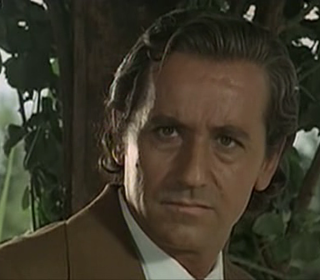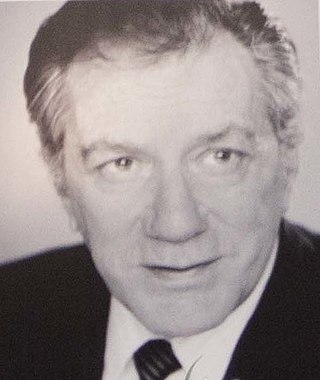
Rosa Vicenta Montserrat Coscolín Figueras known professionally as Gloria Lasso was a Spanish-born canción melódica singer, long based in France. In the 1950s, she was one of the major competitors to Dalida.

Alejandro "Álex" de la Iglesia Mendoza is a Spanish film director, screenwriter, producer and former comic book artist.

Bertha Moss, born Juana Bertha Moscovish Holm, was an Argentine actress of stage, television and film, famous for appearing in many Mexican telenovelas.

Alberto Manuel Rodríguez-Gallego González de Mendoza was an Argentine film actor who appeared in some 114 films between 1930 and 2005, spanning eight decades.

Roque Funes was the most prolific Argentine cinematographer in the history of the Cinema of Argentina whose career spanned over 40 years of cinema.

Joaquín Cordero was a Mexican actor of the cinema, theatre and telenovelas.
"Que No Se Rompa la Noche" literally "May the Night not Break", is a ballad written and produced by Spanish singer-songwriter Manuel Alejandro, co-written by Ana Magdalena, and performed by Spanish singer Julio Iglesias. It was released as the second single from his studio album Un hombre solo (1987). This song became his second number one hit in the Billboard Hot Latin Tracks chart, after his previous single "Lo Mejor de Tu Vida".

Antonio Cunill Cabanellas was an influential Spanish-Argentine playwright, theatre actor, director and instructor.

Fey: Primera Fila is the acoustic album by Mexican pop singer Fey. The live album, part of Sony's "Primera Fila" series, was shot and recorded in Mexico on June 22, 2012 in front of fans and special guests on an invite-only basis. The live album has new renditions of songs from her first three albums, as well as three new tracks. The album features a documentary of the process as well as a live video recording of the concert.
Mariana de la noche is a Venezuelan telenovela produced in 1976 by Venevisión. An original story written by Cuban-born writer Delia Fiallo, it starred Lupita Ferrer and José Bardina as the main protagonists plus Martín Lantigua and Ivonne Attas as the main antagonists.
Antonio Colinas Lobato is a Spanish writer and intellectual who was born in La Bañeza, León, Spain on January 30, 1946. He has published a variety of works, but is considered to be above all a poet. He won Spain's National Prize for Literature in 1982, among several other honors and awards.

Todo Lo Que Soy-En Vivo is a live album by Mexican pop singer Fey. The album was recorded in Mexico City's National Auditorium after the success of her Fey: Primera Fila album. Fey toured this show in various venues in Mexico, with many sold out dates and dates were added due to popular demand. Before going in for an encore performance at the National Auditorium in April 2014, Fey had confirmed that would be the concert date she would record the show in a CD & DVD format. The album was originally slated for a summer 2014 release, but was delayed due to Fey wanting to be involved in the details of the editing process. On December 11, 2014, Fey confirmed via Twitter that the CD & DVD format would be released on December 17, 2014 and the digital version would go worldwide on December 24, 2014 along with the cover art.
Emiliano Redondo (1937–2014) was a Spanish film and television actor.
María Begoña Labraga Picado, better known by the stage name of Mary Begoña, was a Spanish vedette and actress. She started dancing at age 7 and performed in venues in Madrid while she was studying at the Academies of Quiroga, Ompín and Monreal. Then she studied with Antonio Bautista and Sacha Goudine in Barcelona. She debuted in a musical revue at the age of fourteen and during Spanish Civil War was part of the CNT Union. In 1943, Begoña worked in Valencia in Juanita Reina's acting troupe, but returned to Madrid to debut in the Teatro Calderón. In 1945 she appeared in the revue Danubio Azul with Manolo Caracol and Lola Flores and the following year was the principal vedette in the revue De la Tierra a Venus. For the next several years she performed in variety shows with various acting troupes, such as Tres días para quererte (1945), ¡Róbame esta noche! (1947), A La Habana me voy (1948). In 1951, she did a season in the US and then returned to Spain appearing in ¡A vivir del cuento! (1952) and Los líos de Elías (1954). Begoña then formed her own company, which between 1953 and 1960 performed ten different plays. As her career declined in revue style shows, she began performing in comedy theater, film, and television.

Colonia Noche Buena is a neighborhood in Benito Juárez, Mexico City.

Ester Expósito Gayoso is a Spanish actress and model. She is best known for her starring role as Carla Rosón Caleruega in the Netflix teen drama series Élite.
Mariano Vidal Molina was an Argentinian actor.

Ángela Cremonte is a Spanish-Argentine actress. She is best known for her performance playing Elisa in Cable Girls.
This page is based on this
Wikipedia article Text is available under the
CC BY-SA 4.0 license; additional terms may apply.
Images, videos and audio are available under their respective licenses.











